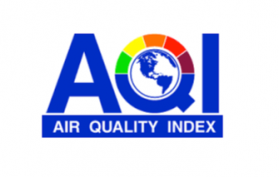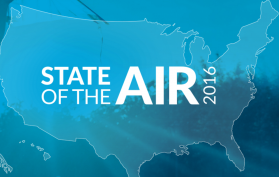Air Quality Forecast
Tuesday, May 3rd, is Green.
Tuesday, May 3rd, is Green.

We’re all familiar with the weather forecast, but what about the air quality forecast? During the summer months, daily air quality forecast updates let the public know if it will be a green, yellow, orange or red air quality day – and each color means something different for our health. As the weather heats up and the risk for poor air quality accelerates, these forecasts can play an important role in helping individuals avoid the harmful effects of air pollution.
The colors represent values within the Air Quality Index (AQI), a numerical system that measures how clean or polluted the air is. The Environmental Protection Agency calculates the AQI for five major air pollutants as regulated by the Clean Air Act: ground-level ozone, particle pollution, carbon monoxide, sulfur dioxide and nitrogen dioxide. With values ranging from 0 to 500, the AQI determines health effects that may be experienced within hours or days after breathing polluted air. The higher the AQI value, the greater the level of air pollution and potential for concerns.
The AQI is divided into six categories, each corresponding to a different level of health concern. Symbolized by the color green, an AQI in the 0-50 range is considered “good,” and air pollution poses little to no health risk. When the AQI ranges from 51-100, the health concern level is “moderate” and symbolized by the color yellow. In this range, air quality conditions are acceptable; however, people who are unusually sensitive to ozone may experience respiratory symptoms.
When the AQI ranges from 101 to 150, air quality conditions are “unhealthy for sensitive groups” and symbolized by the color orange. People with lung disease, older adults and children are at a greater risk from exposure to ozone, while those with heart and lung disease, older adults and children are at greater risk from the presence of particles in the air. An AQI from 151 to 200 represents “unhealthy” air quality conditions and is symbolized by the color red. At this AQI, everyone may begin to experience some adverse health effects, and members of the sensitive groups may experience more serious effects. Any AQI from 201-500, is considered “very unhealthy” or “hazardous,” and can trigger negative health effects and health warnings for the entire population.
The health effects of poor air quality are numerous and can include shortness of breath, coughing, wheezing, headaches, nausea, eye and throat irritation and decreased lung function. Additional risks include aggravation of respiratory problems, asthma, allergies and lung diseases; impairment of the immune system, increased hospital and ER visits and irregular heartbeat, heart attacks and premature death in those with heart or lung disease.
To help keep the public updated on air quality conditions, the Clean Air Partnership posts the daily air quality forecast on our homepage. Residents can also visit the website to sign up to receive the forecast via email. Throughout the summer, the forecast can also be found on our Facebook page or by following the organization on Twitter @gatewaycleanair.
 The American Lung Association’s 2016 State of the Air report ranked St. Louis as the 18th most polluted metropolitan area in the nation for ozone pollution, once again confirming what a critical concern air pollution continues to be locally. And those concerns have the potential to ramp up in the coming months, as the St. Louis area settles into its first summer season featuring stricter ozone standards.
The American Lung Association’s 2016 State of the Air report ranked St. Louis as the 18th most polluted metropolitan area in the nation for ozone pollution, once again confirming what a critical concern air pollution continues to be locally. And those concerns have the potential to ramp up in the coming months, as the St. Louis area settles into its first summer season featuring stricter ozone standards.
Last October, in an effort to further protect public health, the Environmental Protection Agency strengthened the National Ambient Air Quality Standards for ground-level ozone to 70 parts per billion (ppb), down from 75 ppb. With these standards now in effect, the area has the potential to see many more orange and red poor air quality days this summer.
Luckily, there are a number of steps all of us can take to help reduce emissions, and keep air quality in the healthy range.
Since transportation has the most profound impact on air quality, making the choice to spend less time behind the wheel is an easy way to reduce the emissions that lead to poor air quality. Actions like using transit, carpooling and vanpooling, choosing not to idle your vehicle, combining errands into a single trip, walking and biking more, telecommuting and/or adjusting work hours to stay off the road during peak commute times all help take cars off area roads and the related emissions out of our air. These actions are especially critical when poor air quality conditions are in the forecast. In addition, there are many eco-friendly lifestyle changes that can further positively impact air quality, including efforts to conserve energy, recycle, reduce waste and reuse items.
Throughout the summer, area residents can view the daily air quality forecast on our homepage. Visitors can also sign up there to receive the daily forecast via email. The forecast can also be found on our Facebook page and on Twitter @gatewaycleanair.
For most people, your car is your most valuable possession. Your vehicle helps you pay the bills by getting you to and from work. It’s reliable. It’s convenient.
But, it can also be an air pollution nightmare.
Vehicular traffic is the leading source of air pollution in most U.S. cities,  according to the U.S. Environmental Protection Agency (EPA). Although you may not be able to see it, your car’s tailpipe pumps out pollutants such as carbon monoxide, hydrocarbons and oxides of nitrogen.
according to the U.S. Environmental Protection Agency (EPA). Although you may not be able to see it, your car’s tailpipe pumps out pollutants such as carbon monoxide, hydrocarbons and oxides of nitrogen.
Hydrocarbons and oxides of nitrogen react on hot, sunny days to form ground-level ozone. During the summer, high levels of ground-level ozone make it difficult for many people to breathe.
That’s the bad news. The good news is that there are a variety of steps you can take to make sure your car isn’t a pollution machine.
When a vehicle is not properly maintained, its pollution control devices will eventually fail, causing increased emissions. To avoid releasing excessive emissions into the air, follow the recommended maintenance schedule listed in your owner’s manual. Preventative maintenance tips are also available through the Gateway Clean Air Program.
Is your “check engine” or “service engine soon” light on? Responding quickly to this malfunction indicator light can save you money! The light notifies you when something in the engine management or emissions control system has failed or deteriorated. Early diagnosis and repair can prevent more costly repairs, such as replacing a catalytic converter. Responding to the malfunction light in a timely manner will prevent excess vehicle emissions, which improves overall air quality in the region.
The less fuel you burn, the less pollution comes out of your tailpipe. Over time, a fuel-efficient vehicle will save you money in refueling costs. When shopping for a new vehicle, compare the gas mileage ratings of several vehicles. More information is available on the EPA’s Web site at www.epa.gov/autoemissions/.
If your current car is a gas-guzzler, there are ways to improve its gas mileage. Remove unnecessary weight from your vehicle – leave the golf clubs in the garage; take the bag of sand out of the bed of your truck as soon as the ice disappears. Accelerate slowly, and drive at a steady speed. You can improve your gas mileage about 15 percent by driving at 55 mph rather than 65 mph. Reduced gas mileage is an indication that something might be wrong with your vehicle. Take it to a repair shop for diagnosis and repair.
Over the years, scores of print publications have either downsized or gone out of business, creating severe losses for publishers and reporters. J.B. Lester’s The Healthy Planet magazine, however, continues its reign as the only health and environmental magazine in the Greater St. Louis area. for 18 years.
In 1995, Lester left his post as co-editor and co-publisher at the Webster-Kirkwood Times with the goal of starting a new publication devoted to covering environmental and health issues. A couple years later, Lester managed to get The Healthy Planet off the ground thanks to financial help from a family member. But, as Lester recalls, the first year was a difficult one.
“Because the term ‘green’ was still unconventional at the time, it took us awhile to get our message across,” noted Lester. “But as area residents have continued to gain a greater understanding of what it means to ‘go green,’ we’ve seen the magazine’s success grow steadily over the years.”
Today, The Healthy Planet magazine is available at more than 800 locations in the Greater St. Louis area and its monthly readership has  grown to 90,000. With extensive coverage every month, The Healthy Planet includes sections like “Green & Growing,” “Kids’ Planet” and “Fresh Fare” to educate readers about organic and sustainable gardens, children’s activities that highlight green living and sustainable ways to eat healthy. Other special sections such as the Summer Camp Guide, the Holiday Green Shopping Guide and the Growers & Market Guide connect readers to resources that will help them to maintain a healthy and eco-friendly lifestyle.
grown to 90,000. With extensive coverage every month, The Healthy Planet includes sections like “Green & Growing,” “Kids’ Planet” and “Fresh Fare” to educate readers about organic and sustainable gardens, children’s activities that highlight green living and sustainable ways to eat healthy. Other special sections such as the Summer Camp Guide, the Holiday Green Shopping Guide and the Growers & Market Guide connect readers to resources that will help them to maintain a healthy and eco-friendly lifestyle.
“I think every major city needs a magazine like The Healthy Planet because we offer important resources for people who are interested in both improving the quality of their lives and prolonging the life of our planet,” Lester said. “We have made our mark on our community and plan to keep offering what our readers want.”
As a result of Lester’s life-long interest in green and healthy living, he and his wife Niki practice what they preach by incorporating eco-friendly alternatives into every possible aspect of their lives at home and at the office. His family recycles, uses only energy-saving light bulbs, carpools to work often and eats primarily grass-fed, free-range meat. To lessen his carbon footprint, Lester said he has been using an electric lawn mower, a natural gas grill and organic yard and garden practices for years.
Poor air quality is part of what inspires Lester to not only maintain, but also continuously improve his green lifestyle. Asthma and other respiratory illnesses have increased over the years and are directly linked to poor air quality, especially in St. Louis and the Mississippi Valley. And, asthma has played a direct role in spurring Lester’s green lifestyle, because one of his daughters suffers from sports-induced asthma. As a result, Lester said he would like to see more St. Louis area residents doing their part to improve the region’s air quality by using mass transit, bicycling, walking and driving more fuel-efficient, eco-friendly vehicles.
To help his readers easily incorporate long-term, eco-friendly practices into their daily lives, Lester stresses the importance of taking small steps. That’s why each issue of The Healthy Planet is focused on introducing environmentally friendly alternatives to readers, which Lester hopes will spur greener lifestyles overall. Easy steps he promotes include starting a home recycling program, changing out light bulbs and learning more about organic gardening.
“Everyone has a part in the problem, but we can all be a part of the solution,” Lester said. “Our publication offers great information on small steps that individuals can take right now to get the ball rolling.”
To learn more about going green and helping improve the region’s air quality, visit www.cleanair-stlouis.com or call the American Lung Association of the Upper Midwest at 314-449-9149. To learn more about The Healthy Planet, visit www.thehealthyplanet.com or call (314) 962-7748.
Did you know that spending an extra 10 minutes sitting in traffic during your commute can quickly adds up to 84 hours in the car per year! Traffic is wearisome, not only for you but for your health. Fumes from car exhaust, which mixes with heat and sunlight to form ground-level ozone, makes it difficult for us all to breathe. However, you can help clear the air in our region this summer by not driving in your car alone during rush hour traffic. Impossible, you think? Here are some commute ideas for you to consider.
The first option is to consider an alternate mode of transportation to work. The MetroBus and MetroLink have routes that cover St. Louis on both sides of the river, and you can log onto www.metrostlouis.org to find a schedule and route near you. Services are available for Madison County, Ill. residents from Madison County Transit at www.mct.org. In addition, Citizens for Modern Transit (CMT) offers opportunities to register your home and work addresses online via its website at www.cmt-stl.org and receive a personalized transit route from home to work, the schedules and service times for your commute.
If transit isn’t an option,try carpooling to work—it’s as easy as calling Ridefinders at 1-800-VIP-RIDE or visiting www.ridefinders.org.  Carpooling saves miles and wear on your car, and gives you someone to talk to during those long daily commutes. RideFinders can match you up with a list of potential carpoolers that both live and work near you.
Carpooling saves miles and wear on your car, and gives you someone to talk to during those long daily commutes. RideFinders can match you up with a list of potential carpoolers that both live and work near you.
An added benefit of transit and carpooling is the Guaranteed Ride Home (GRH), an incentive that provides a limited number of subsidized cab rides in case of an unexpected emergency. Both CMT and Ridefinders offer the GRH for those who use transit and carpool and vanpool.
Other programs, such as flextime and a compressed work week, may also be available through some employers. Flextime changes the hours of an employee’s workday. For example, instead of working the typical 8 am to 5 pm shift, employees flex their schedule to work 6 am to 3 pm, 10 am to 7 pm, or any other combination the employer agrees upon. A compressed work week changes the hours of your day into longer shifts, working 10 hours a day four days a week, allowing you to avoid rush hour traffic and giving you one extra day off every week!
Choosing any of these options makes sense in many ways— it saves you time and money, and, since your car is idling less in traffic, it is polluting less and helping to reduce the thousands of pounds of pollution our cars create EVERY DAY. Clean air is everyone’s responsibility; so set a good example for others by taking action and try a more environmentally friendly commute.
Having devoted his career to the research and data analysis of global tropospheric ozone, Dr. Jack Fishman, Professor of the Department of Earth & Atmospheric Sciences and Director of the Center for Environmental Sciences at Saint Louis University, is the man behind St. Louis’ Ozone Garden Project. Working alongside the Saint Louis Science Center and the Missouri Botanical Garden, Fishman’s mission is to educate the public on the toxic effects of rising ozone pollution on plant species.

Since the onset of the industrial revolution, ozone levels emitted by the combustion of fossil fuels have more than doubled in the lowest layer of the Earth’s atmosphere, known as troposphere. Today, as background concentrations of ozone pollutants continue to rise, ozone pollution is not only creating health concerns for humans, but is also causing vegetation damage and declines in crop productivity.
“The ozone garden idea was first used by the National Park Service,” said Fishman whose 40- year research career has focused on looking at ozone as a pollutant. “Unfortunately, for a very long time, most people weren’t aware of the potentially harmful effects of ozone, even at levels that are considered ‘background’ concentrations. As a result, the ozone gardens became a living display of the effects of ozone pollution on the biosphere.”
In the St. Louis area, Fishman’s efforts have resulted in the creation and maintenance of three established ozone gardens, which are located at the Saint Louis Science Center’s McDonnell Planetarium, Grant’s Farm and Southwestern Illinois College in Belleville, Ill. It is likely that two more gardens will be grown by 2016 – one at the Missouri Botanical Garden and another in Granite City, Ill. Nationally, more than a dozen Ozone Gardens have been planted that have used seeds, plants, and guidance from the St. Louis project.
The gardens feature bio-indicator plants with leaves that display damage when ozone pollution levels are high, but still below levels for which pollution alerts are issued. During the spring and summer months, Saint Louis University staff and student volunteers are responsible for inspecting the plants and collecting leaf damage data.
Each of the gardens also contains a weather station and an ozone (O3) monitor, which records air quality conditions every 15 minutes and transmits the data collected to a receiver online. The monitoring equipment is connected to the Global Ozone (GO3) Project, which provides institutions worldwide with the ability to upload their pollutant information to a public database for graphing and display on Google Earth. This data is publicly available through the GO3 website at http://go3project.com/network2/index.php/pages/ozone-data.
“We have seen tremendous improvement in the U.S. and Europe as we start to create a global trend of pollution control,” said Fishman. “As a result, the very high urban pollution levels found before the implementation of the Clean Air Act in 1970 are no longer found. On the other hand, global levels in the non-urban atmosphere are still increasing and are linked to the increased use of fossil fuels. It is a complicated problem that generally is not understood by the public. But the bottom line is that we need to think globally and act locally. It starts with reducing our carbon footprint and finding alternative ways to create energy.”
At an individual level, there are a variety of things we can all do to help reduce the emissions that lead to poor air quality. These actions include driving less by carpooling and vanpooling, using mass transit, and walking and biking when possible to get around town. Efforts to conserve energy at home and at work can also play an important role in reducing demands on power plants and the related emissions they create.
To learn more about the St. Louis Ozone gardens, visit http://www.slu.edu/department-of-earth-and-atmospheric-sciences-home/center-for-environmental-sciences/ozone-garden-home. For information on steps you can take to help reduce the emissions that lead to ozone pollution, visit The St. Louis Regional Clean Air Partnership’s website at www.cleanair-stlouis.com, find the organization on Facebook, or follow the organization on Twitter @gatewaycleanair.
Dr. Jack Fishman’s work on the St. Louis Ozone Garden Project is just one highlight of his distinguished career, which includes 31 years with the NASA Langley Research Center, where he was a Senior Research Scientist and Branch Head. During his time at NASA, he studied tropospheric chemistry, and pioneered the use of satellite observations that provided an eye-opening perspective of the extent of global pollution. After retiring from NASA, Fishman joined the Saint Louis University faculty as a Professor in the Department of Earth & Atmospheric Sciences and was subsequently appointed Director of the Center for Environmental Sciences. The first Ozone Garden was planted in 2012.